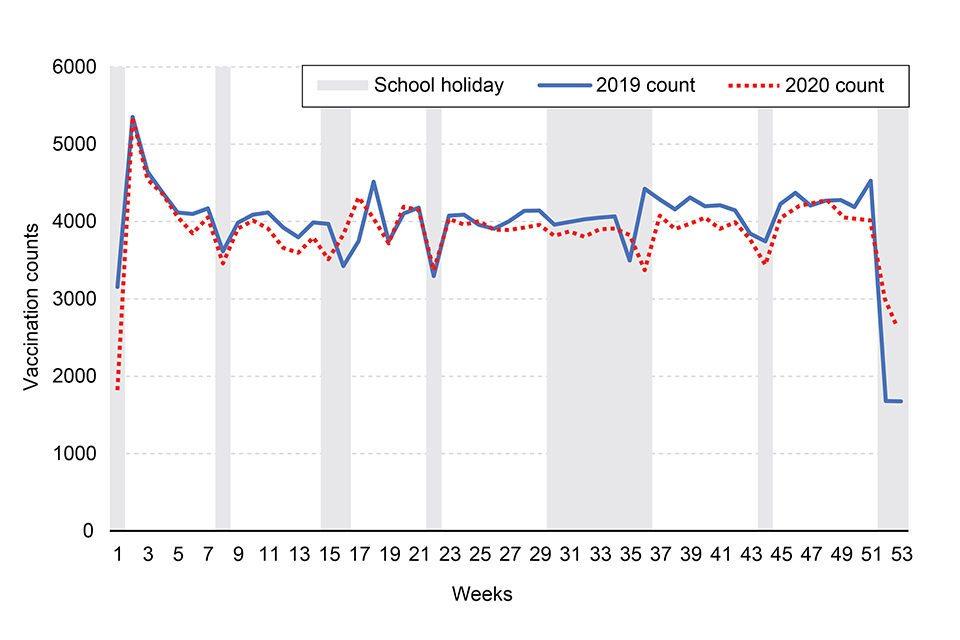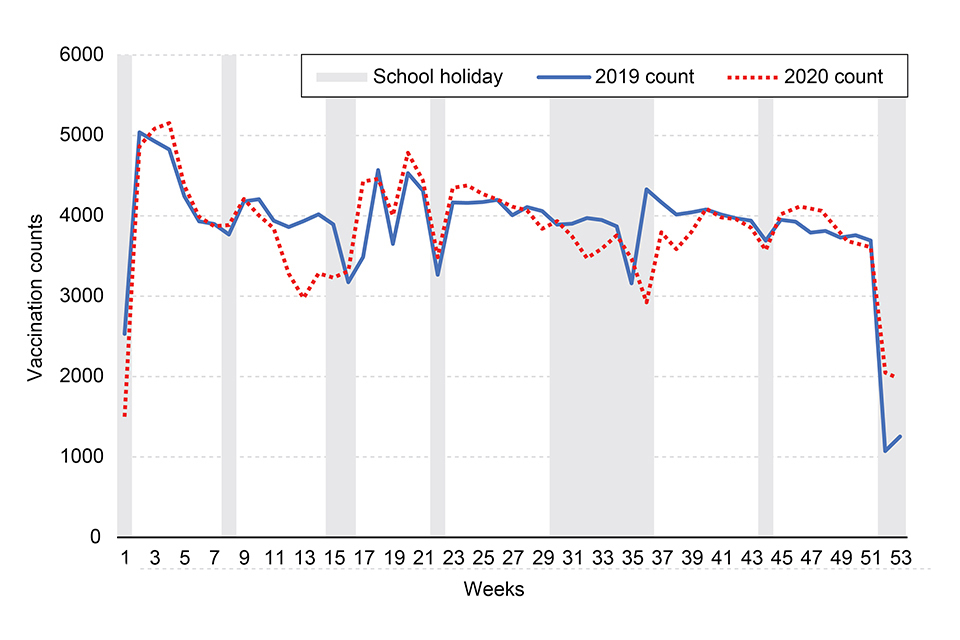Impact of COVID-19 on childhood vaccination counts up to week 53, 2020
Updated 14 September 2021
Applies to England
Introduction to the tenth report
This tenth report, presenting vaccination counts data up to week 53 of 2020 (compared with the same period in 2019) in the 3 charts below, should be read in conjunction with the last published full report: Impact of COVID-19 on childhood vaccination counts to week 51 and vaccine coverage to November 2020 in England: interim analyses, HPR 15(1).
The charts below show that:
- the number of dose 1 Hexavalent vaccine doses delivered in England in week 53 (Figure 1) were lower than during the same week in 2019, although the overall difference in vaccination counts delivered in 2020 was lower than in 2019 (Figures 1 and 3)
- the number of dose 1 MMR vaccine doses delivered in England in week 53 (Figure 2) were higher than during the same week in 2019, although the overall difference in vaccination counts delivered in 2020 was lower than in 2019 (Figures 2 and 3)
- overall vaccination counts for Hexavalent and MMR vaccine remain lower, by 2.7 and 1.2 percentage points, respectively, by week 53 in 2020, than the overall vaccination counts by week 53 in 2019
It should be noted that the vaccine count data presented here is a proxy measure for the vaccine coverage data that is being reported on a monthly basis.
Hexavalent vaccination counts to week 53
Figure 1 below shows dose 1 Hexavalent vaccination counts in infants younger than 6 months in The Phoenix Partnership (TPP) practices in England, by week, in 2019 and 2020. School holidays for the 2020 calendar year are shown in grey (see HPR 15(1) report for full notes on this graph).

MMR vaccination counts to week 53
Figure 2 below shows MMR 1 vaccination counts in infants aged 12 to 18 months in TPP practices in England, by week, in 2019 and 2020. School holidays for the 2020 calendar year are shown in grey (see HPR 15(1) report for full notes on this graph).

Percentage change in vaccination counts in 2020 compared with 2019, to week 53
Figure 3 below shows percentage change in dose 1 Hexavalent vaccination counts (in infants under 6 months), and MMR 1 vaccination counts (in infants aged 12 to 18 months), in 2020 compared to 2019, by week, in TPP practices in England. Please note that Christmas day and Boxing day fell on different days of the week and may account for some of the differences in 2019 compared to 2020 near the end of the year.

Methods
Aggregated weekly vaccination counts from 2019 and 2020 for dose 1 Hexavalent (diphtheria, tetanus, pertussis (whooping cough), polio, Haemophilus influenzae type b (Hib) and hepatitis B) delivered to infants 6 months and younger, and MMR1 (first dose of measles, mumps and rubella vaccine) to children between the ages of 12 and 18 months, were provided by the general practice (GP) information technology (IT) supplier, TPP. Weekly trends in vaccination counts were compared between 2019 and 2020.
TPP represents approximately 38% of data for all GP practices in England and some regions are less represented than others.
